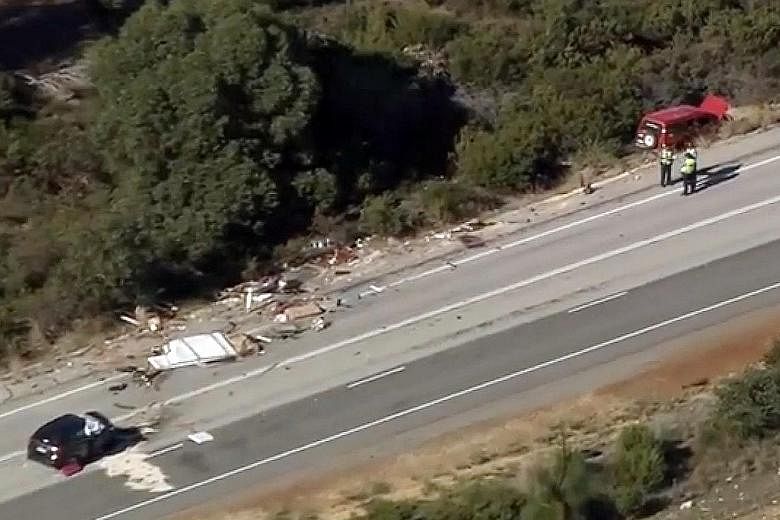Singaporeans who are planning to go overseas on driving holidays should take concrete steps to ensure their safety.
Mr Bernard Tay, president of Automobile Association Singapore, and other local experts said this after news of yet another accident involving a Singaporean driving overseas.
A 40-year-old business analyst, Mr Y. L. Tan, was driving on the Indian Ocean Drive, a scenic coastal road near the Western Australian city of Perth, last Monday when he crashed. He died at the scene while his wife and their two children escaped with minor injuries.
Driving accidents involving Singaporeans overseas have been occurring regularly over the last few years.
Said Mr Tay: "Singaporeans should take steps to adequately understand driving culture, road and weather conditions. They should also plan their route in advance and physically prepare themselves for the driving ahead."
As driving holidays become increasingly popular among Singaporeans, drivers need to be aware that road conditions here are also vastly different from those overseas, said local experts.
Mr Gerard Pereira, 60, a training manager at the Singapore Safety Driving Centre (SSDC), said: "Singaporeans are not used to the long drives and the weather in other countries, as well as other issues like fast moving heavy vehicles."
-
Tips on driving safely overseas
Essential tips for driving overseas from the Automobile Association of Singapore:
Understand the culture and road conditions
•Get to know the local driving speed and the road conditions. Orientate yourself with the vehicle prior to the actual drive. Familiarise yourself with the use of maps or Global Positioning System.
•Check the Star and Risk Ratings of roads, which can be found on International Road Assessment Programme websites.
•Find out about the terrain along your route and ensure that you rent a car that is able to handle it.
Understand the weather conditions
•Stay updated on weather conditions through news channels.
Physical preparation
•Be aware of the impact of jet lag. Make sure that you get sufficient rest before you start driving.
•Never fight fatigue. Be sure to stop and have a rest if you are feeling tired.
•Take a break of a minimum of 15 minutes at a rest point every two hours.
Plan your trip
•Research all the relevant information about your route, find out point-to-point route options and plan your route in advance, using an update-to-date physical map or online map.
Singaporeans, like investor relations consultant Jonathan Ross Yeoh, 28, have experienced near misses due to weather conditions.
Speaking about a driving incident in Japan while on holiday with his girlfriend in November 2015, he said: "It was snowing and we were heading back after dinner. We were going relatively slowly at about 40kmh. But still, when we were nearing a bridge, I lost control of the car and it skidded for about five to eight seconds."
Road rules and conditions overseas also vary immensely from country to country.
For example, on German highways, colloquially referred to as the "autobahn", there is no federally mandated speed limit for some classes of vehicles, though an advisory limit of 130kmh does exist.
Also, foreign traffic rules can be baffling for Singaporeans. In Melbourne, for example, on roads shared with trams, motorists have to perform a " hook turn" at certain junctions, where they turn from the leftmost lane instead of the rightmost lane, as practised here.
Some, like programme manager Jael Lai, 25, have had accidents due to differences in laws and signage.
She said that in Australia, there are no yellow boxes to help drivers turn into lanes safely, so when she was turning into a small lane, she got into an accident with a car that crashed into the back of her car.
Aside from unfamiliar weather conditions and differences in signage, the most dangerous challenge that Singaporeans can face is, perhaps surprisingly, driving on long straight roads.
Mr Pereira said: "Straight roads are the most dangerous part of driving overseas. There are many traffic lights on roads in Singapore and it is a small country, so the drives are not as long, and there are many breaks. In other countries, there are long drives with little rest, concentration can dip, causing accidents."
Drivers echoed the sentiment. Ms Lai said: "In Australia, the endless driving (from town to town) can be quite dangerous, especially at night when you're surrounded by darkness - it's easy to fall asleep."
Road tragedies overseas involving Singaporeans
MAY 4, 2017
A Singaporean couple were killed in a car crash in New Zealand when their camper van crossed the centre line for "unknown reasons" and crashed into an oncoming pick-up truck, police said.
The accident happened on State Highway 1, south of Dunsandel, a township about 40km south of Christchurch.
Ms Rena Ong, 29, was on a 10-day trip with Mr Chen Zhihao, 30, to celebrate her birthday when tragedy struck.
NOV 29, 2015
Singaporean Lew Wei Kiong was driving a rented Toyota when he crossed the double yellow lines on the highway to allegedly overtake a group of cars. But he crashed into two cars and a motorcycle travelling towards him.
Lew, 32, was charged with dangerous driving in the crash which killed the motorcyclist. He was found guilty on June 3 last year, disqualified from driving and ordered to pay NZ$27,000 (then S$25,500) for causing emotional harm.
But it was determined later that he had fallen asleep at the wheel instead. His charge was eventually downgraded to one of aggravated careless driving in April last year.
OCTOBER 2014
On Oct 1, Singapore Airlines first officer Benjamin Wu Yonghao, 32, was driving a rented Toyota car with four colleagues in it when he ran a stop sign at a cross-junction just outside Christchurch, and hit a four-wheel-drive towing a horse trailer.
On Oct 10, Wu was ordered to pay NZ$10,000 each to two colleagues who were seriously hurt.
Correction Note: This story has been edited to reflect the amended charge of aggravated careless driving for Lew Wei Kiong, who was originally charged with dangerous driving. We are sorry for the error.


